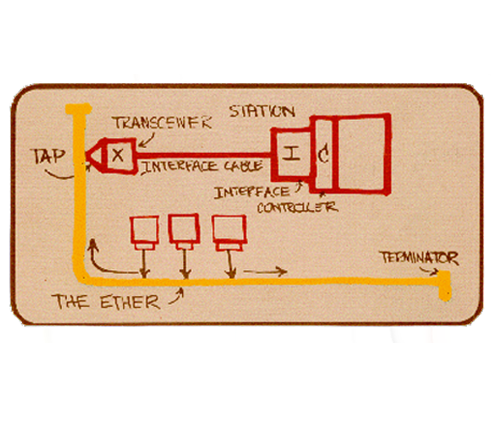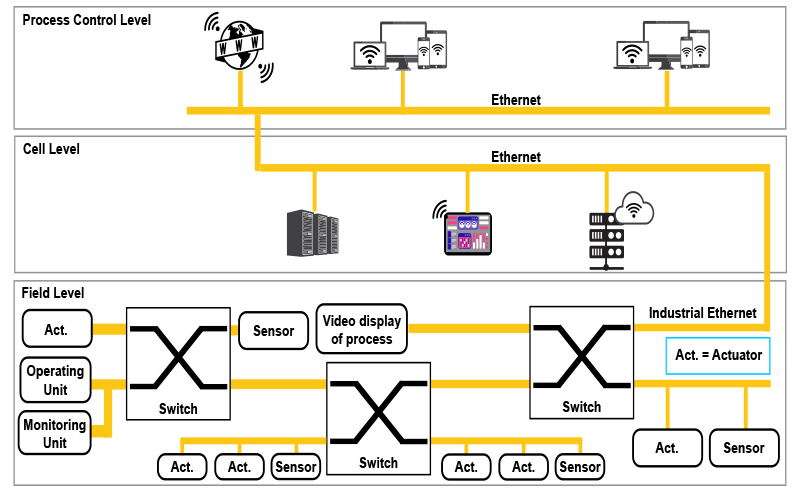The growth and future of Ethernet technology. Discover the benefits of using Ethernet in the field of industrial automation. Learn how Ethernet fits in automation from the office based process control level to the factory floor field level.
Industrial Ethernet
What is Ethernet?
Ethernet was originally developed by Xerox in 1975 for the transmission of data. Ethernet is based on a concept by Dr Robert Metcalfe dating from 1973 describing the transfer of data between several networked stations connected by a coaxial cable.
Ethernet was standardised in the IEEE (Institute of Electrical and Electronics Engineers). The Ethernet was standardised in the IEEE 802 in the 1980s, since then, it has been extended many times.
Since the 1990s Ethernet has undergone a series of further developments in the following areas:
Transmission media
- Fibre optics
- Wireless technology
Data transmission rates
- Fast Ethernet 100 Mbit/s (1995)
- Gigabit Ethernet 1 Gbit/s (1999)
- 10 Gigabit Ethernet (Present)
Network topologies
Having gained importance in the field of industrial automation, Ethernet today is the most prevalent technology used in commercial EDP systems around the globe. The Ethernet protocol is embedded on inexpensive controller chips, combining this with wide distribution and availability, Ethernet is an economic solution for network connections.
Switched Ethernet
Switched Ethernet is a network in which each Ethernet component is assigned to a part in a switch. This means only one station is ever connected to each port. As a result, collision no longer occurs due to the point to point connections between network components and other terminal devices.
Preventing collisions ensures that each point-to-point connection has exclusive use of the full network bandwith. Therefore, full duplex operation is possible, the second pair of Ethernet wires which were originally required for collision detection can now be used for transmissions, which leads to considerable increase in data throughput.
Advantages
- Guaranteed collision-free networks, because only one component is assigned to each port
- Rapid switching of data packets
- Considerable increase in data throughput as a result of full duplex operation
- Deterministic operation is possible due to elimination of collisions
Network size
In theory, there is no limit to the possible size of a switched Ethernet network. The maximum cable length of a point-to-point connection is determined only by the physical transmission properties. In practice, the actual possible length of the cable is determined by the types of connectors and lines used.
Why Industrial Ethernet?
- Intelligence is shifting towards individual field components forming decentralised, distributed structures of automation.
- The growth of Industry 4.0 and IIoT.
- Vertical communication is being integrated through all levels of the automation pyramid.
- Tried and trusted uniform protocol in the form of Ethernet with TCP / IP - from the office environment through to the machine / sensor.
Automation Pyramid: Based on Ethernet
Technical Terms:
EDP Systems
Electronic Data Processing, also known as IS (Information Services / Systems) or MIS (Management Information Services / Systems). This is the processing of data by a computer and its programs in an environment involving electronic communication.
Collision
CSMA/CD
Carrier Sense Multiple Access with Collision Detection. This network access method consists of the component checking if the network is free for transmissions (Carrier Sense).
Simultaneous Collision Detection checks are made at the begining of transmissions to see if another device has also began to transmit. If this is the case, a collision occurs. As a result, all participating network components stop transmitting and wait for a randomly determined period of time before transmitting again.
TCP/IP
A set of rules that governs the connection of a computer system to the internet.
Transmission Control Protocol is a standard that defines how to establish and maintain a network conversation via which application programs can exchange data. TCP works with the Internet Protocol defines how computers send packets of data to each other.
Actuator
A device that causes a machine or another device to operate.





